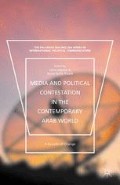Abstract
Visual imagery has increasingly played an important role in mediating popular opinion formation between the “Arab world” and the “West” in recent years, in particular with respect to what is commonly referred to as the “Israeli-Palestinian conflict.” Considering the volume of digital imagery decontextualized, reproduced, and circulated across time and space, it is not a wonder that a two-way street of distorted impressions has emerged. Reinforced through linguistic and cultural divides, such distortions are hardly blind to existent power asymmetries. The visual imagery of Palestinians that selectively filter through the powerful mainstream Western media apparatuses have played an important role in justifying Western and Israeli government policies in Israel/Palestine and the region at large—policies that include protracted occupation, expansionist settler-colonialism, and military repression.1
Access this chapter
Tax calculation will be finalised at checkout
Purchases are for personal use only
Preview
Unable to display preview. Download preview PDF.
References
Abou Hashhash, Mahmoud. 2006. “On the Visual Representation of Martyrdom in Palestine.” Third Text, 20(3): 391–403.
Achcar, Gilbert. 2004. Eastern Cauldron: Islam, Afghanistan, Palestine and Iraq in a Marxist Mirror. London: Pluto.
Aisling, Byrne. 2011. “Building a Police State in Palestine.” Foreign Policy, January 18.
Amundsen, Inge, George Giacaman, and Mushtaq Khan (eds.). 2004. State Formation in Palestine: Viability and Governance During a Social Transformation. London: Routledge Curzon.
Arab Palestinian Investment Company (APIC). 2009a. “SKY for Advertising, Event Management & PR Company.” Accessed September 20, 2013, at: www.apic-pal.com/earticlepage.php?artid=43.
Arab Palestinian Investment Company (APIC). 2009b. “About the Arab Palestinian Investment Company (APIC).” Accessed September 20, 2013, at: www.apic-pal.com/earticlepage.php?artid=78.
Asda’a Burson-Marsteller. n.d. “Asda’a Burson-Marsteller.” Accessed September 20, 2013, at: www.asdaabm.com/content.php?menu=about.
Boullata, Kamal. 2009. Palestinian Art 1850–2005 (Preface by John Berger). London and San Francisco: Saqi.
Dabashi, Hamid (ed.). 2006. Dreams of a Nation (Preface by Edward Said). London and New York: Verso.
Entous, Adam. 2009. “Firms Run by President Abbas’s Sons Get U.S. Contract, Reuters, April 22.” Accessed September 9, 2009, at: http://uk.reuters.com/article/2009/04/22/uk-palestinians-aid-abbas-exclusive-sb-idUKTRE53L2R020090422?sp=true.
Friedman, Thomas. 2009. “Green Shoots in Palestine.” New York Times, 4.
Friel, Howard and Richard Falk. 2007. Israel-Palestine on Record: How the New York Times Misreports Conflict in the Middle East. London: Verso.
Hanieh, Adam. 2008. “Palestine in the Middle East: Opposing Neoliberalism and US Power, Parts 1 & 2.” MR Zine. Accessed September 9, 2009, at: http://mrzine.monthlyreview.org/2008/hanieh190708a.html.
Hanieh, Adam. 2011. “The Internationalisation of Gulf Capital and Palestinian Class Formation.” Capital & Class, 35: 81–106.
Hever, Shir. 2010. The Political Economy of Israel’s Occupation: Repression beyond Exploitation. London: Pluto Press.
Honig-Parnass, Tikva and Toufic Haddad. 2007. Between the Lines: Israel, the Palestinians, and the U.S. War on Terror. Chicago: Haymarkets Books.
Israeli Occupation Archive. Accessed December 7, 2014, at: http://www.israeli-occupation.org/.
Middle East Project of the Democracy and Governance Program, Human Sciences Research Council of South Africa. 2009. “Occupation, Colonialism, Apartheid? A Re-assessment of Israel’s Practices in the Occupied Palestinian Territories under International Law.” Cape Town, South Africa.
PADICO Annual Report. 2010. Accessed December 5, 2014, at: http://www.padico.com/library/634473384751562500.pdf.
Palestinian Center for Human Rights. 2011. “Statistics Related to the Al Aqsa (Second) Intifada. October 2010 Update.” Accessed September 20, 2013, at: www.pchrgaza.org/portal/en/index.php?option=com_content&view=article&id=3044:statistics-related-to-the-al-aqsa-second-intifada-&catid=55:statistics&Itemid=29.
Palestinian Central Bureau of Statistics. Accessed September 20, 2013 at: www.pcbs.gov.ps/default.aspx.
The Palestine Poster Project. Accessed December 5, 2014, at: at: www.lib-erationgraphics.com.
Paltel Group Annual Report. 2010. Accessed December 5, 2014, at: http://www.paltelgroup.ps/downloads/reports/20120604143748.pdf.
Philo, Greg and Mike Berry. 2004. Bad News from Israel. London: Pluto Press.
Philo, Greg and Mike Berry. 2011. More Bad News from Israel. London: Pluto.
Said, Edward. 1997. Covering Islam: How the Media and the Experts Determine How We See the Rest of the World. London: Vintage.
Sayigh, Yezid. 1997. Armed Struggle and the Search for State: The Palestinian National Movement 1949–1993. Oxford: Oxford University Press.
Shohat, Ella. 2006. Taboo Memories, Diasporic Voices. Durham, NC: Duke University Poress.
Taghdisi-Rad, Sahar. 2011. The Political Economy of Aid in Palestine: Relief from Conflict or Development Delayed? London: Routledge.
The Washington Institute for Near East Policy. 2009. “Lieutenant General Keith Dayton, U.S. Security Coordinator, Israel and the Palestinian Authority,” Thursday, May 7. Accessed September 20, 2013, at: www.washingtoninstitute.org/html/pdf/DaytonKeynote.pdf.
Wertheim, Moshe. 1997. “Can the Law Survive a Change in Political Sentiments?” Justice, No. 12, March: 22–26.
World Bank Projects and Operations—WBGS. 2013. Accessed September 2013, at: http://web.worldbank.org/external/projects/main?pagePK=217672&piPK=95916&theSitePK=40941&menuPK=223661&category=regcountries®ioncode=6&countrycode=GZ.
Editor information
Copyright information
© 2016 Toufic Haddad
About this chapter
Cite this chapter
Haddad, T. (2016). Martyrs and Markets: Exploring the Palestinian Visual Public Sphere. In: Jayyusi, L., Roald, A.S. (eds) Media and Political Contestation in the Contemporary Arab World. The Palgrave Macmillan Series in International Political Communication. Palgrave Macmillan, New York. https://doi.org/10.1057/9781137539076_5
Download citation
DOI: https://doi.org/10.1057/9781137539076_5
Publisher Name: Palgrave Macmillan, New York
Print ISBN: 978-1-349-56621-1
Online ISBN: 978-1-137-53907-6
eBook Packages: Literature, Cultural and Media StudiesLiterature, Cultural and Media Studies (R0)

